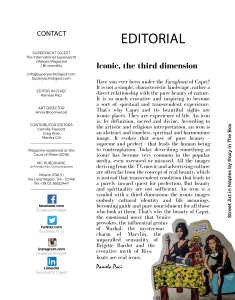[two_third]
[dropcap]H[/dropcap]ave you ever been under the Faraglioni of Capri? It is not a simple, characteristic landscape, rather a direct relationship with the pure beauty of nature. It is so much evocative and inspiring to become a sort of spiritual and transcendent experience. That’s why Capri and its beautiful sights are iconic places. They are experience of life. An icon is, by definition, sacred and divine. According to the artistic and religious interpretation, an icon is an abstract and timeless, spiritual and harmonious image. It evokes that sense of pure beauty – supreme and perfect – that leads the human being to contemplation. Today describing something as iconic has become very common in the popular media, even overused or misused. All the images deriving from the TV, movie and advertising culture are often far from the concept of real beauty, which is instead that transcendent condition that leads to a purely inward quest for perfection. But beauty and spirituality are not sufficient. An icon is a symbol with a third dimension: the iconic images embody cultural identity and life meanings, becoming guide and pure nourishment for all those who look at them. That’s why the beauty of Capri, the emotional move that Venice provokes, the influential genius of Warhal, the mysterious charm of Marylin, the unparalled sensuality of Brigitte Bardot and the evocative myth of Riva boats are real icons.
[/two_third][one_third_last]

[/one_third_last]







